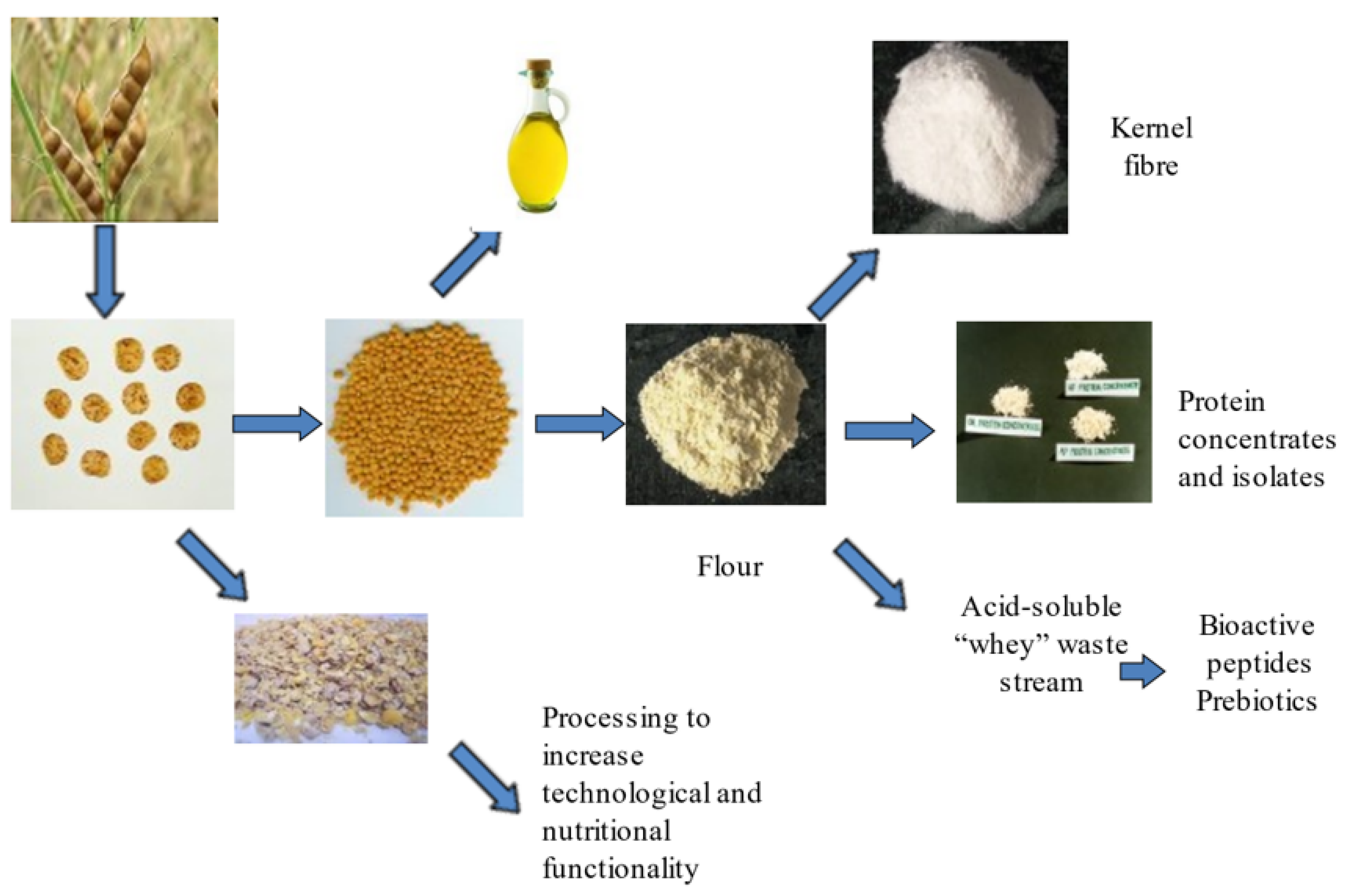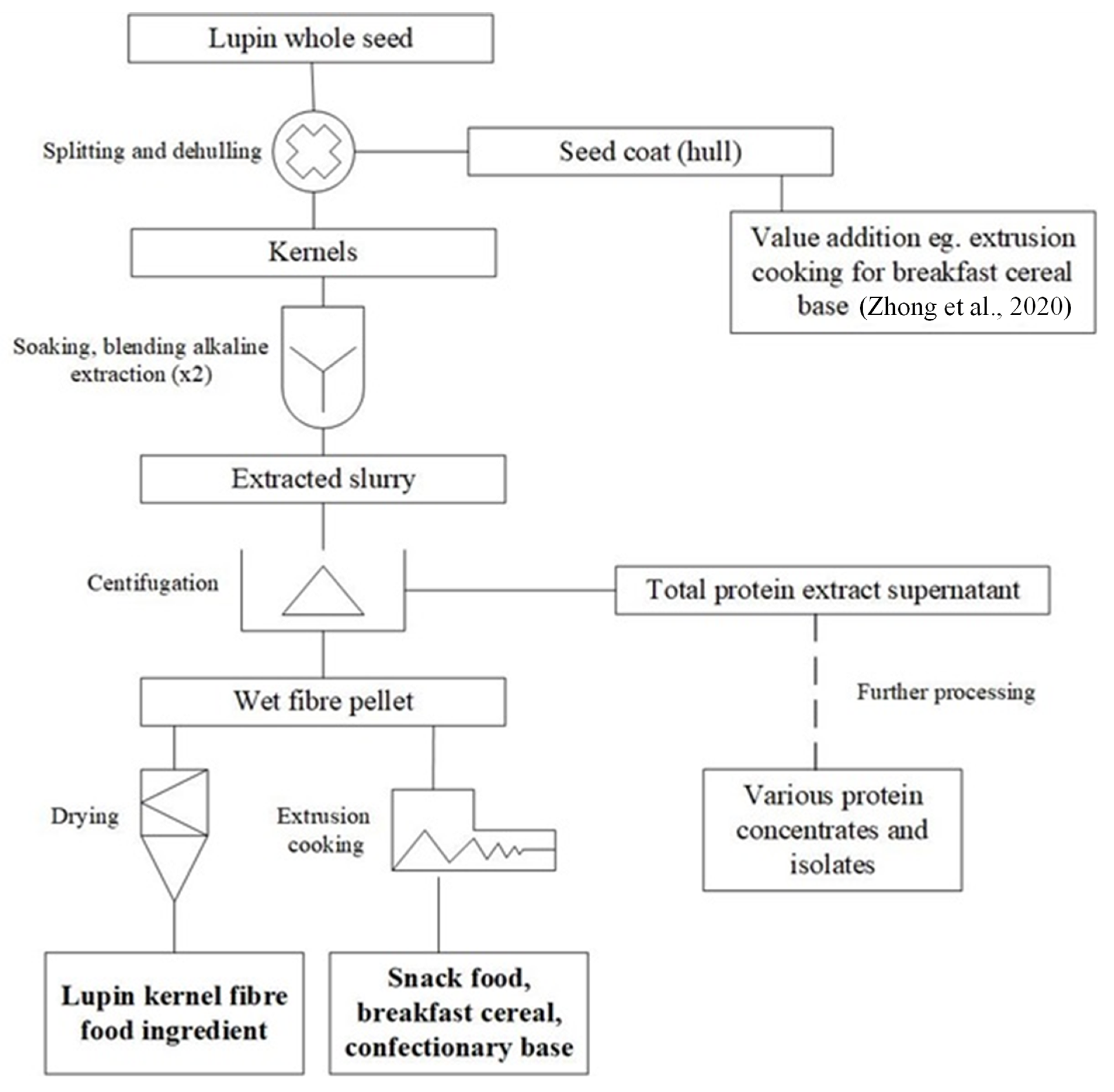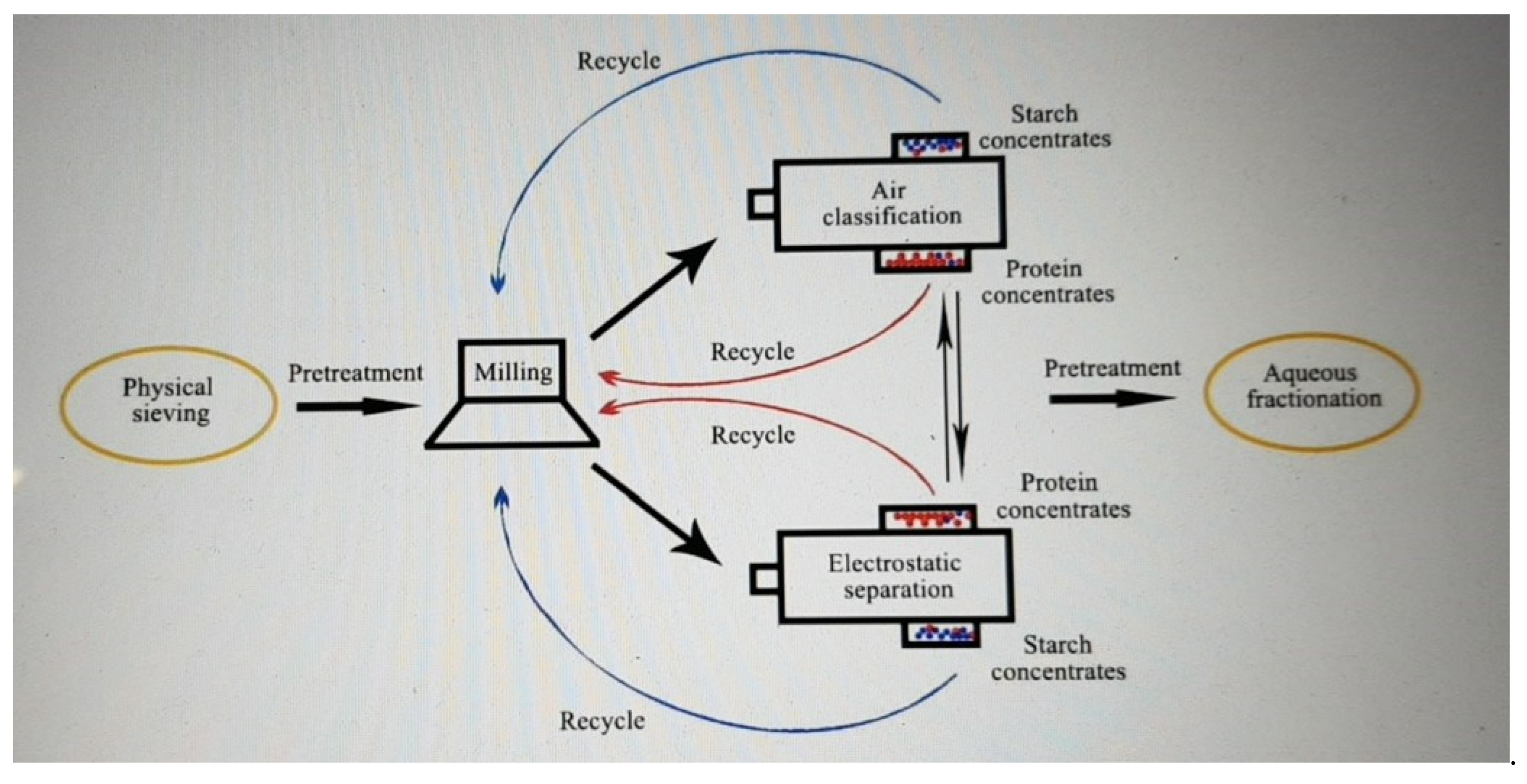Lupin Kernel Fibre: Nutritional Composition, Processing Methods, Physicochemical Properties, Consumer Acceptability and Health Effects of Its Enriched Products
Abstract
:1. Introduction
2. Dietary Fibre in Lupin Seeds
2.1. Dietary Fibre of Lupin Hull
2.2. Dietary Fibre of Lupin Kernel
3. Manufacture of LKF as a Food Ingredient
3.1. Processing Approaches
3.1.1. Wet Processing: Methods, Advantages and Disadvantages
3.1.2. Dry Processing: Methods, Advantages and Disadvantages
4. Composition and Techno-Functionality of LKF Food Ingredients
4.1. Typical Composition of LKF Food Ingredients
4.2. Physicochemical Properties of LKF Food Ingredients
4.2.1. Colour, Odour, Flavour and Texture
4.2.2. Hydration, Water Binding and Viscosity
4.2.3. Oil Binding
4.2.4. Consumer Acceptability of Lupin Kernel Fibre-Enriched Food Products
5. Commercial Examples of LKF Food Ingredients and Their Use in Foods
6. Evidence of Health Benefits of LKF from Human Trials
6.1. Metabolic Syndrome Protection
6.2. Appetite and Body Weight Reduction
6.3. Cholesterol and Blood Pressure
6.4. Protection from Type 2 Diabetes
6.5. Potential Gastrointestinal Health Benefits
7. Conclusions
Author Contributions
Funding
Conflicts of Interest
References
- Písaříková, B.; Zralý, Z. Dietary fibre content in lupine (Lupinus albus L.) and soya (Glycine max L.) seeds. Acta Vet. Brno 2010, 79, 211–216. [Google Scholar] [CrossRef]
- Zhong, L.; Ali, H.; Fang, Z.; Wahlqvist, M.L.; Hodgson, J.M.; Johnson, S.K. Lupin seed coat as a promising food ingredient: Physicochemical, nutritional, antioxidant properties, and effect of genotype and environment. Int. J. Food Sci. Technol. 2020, 55, 1816–1824. [Google Scholar] [CrossRef]
- Villarino, C.B.; Jayasena, V.; Coorey, R.; Chakrabarti-Bell, S.; Johnson, S. The effects of bread-making process factors on Australian sweet lupin-wheat bread quality characteristics. Int. J. Food Sci. Technol. 2014, 49, 2373–2381. [Google Scholar] [CrossRef]
- Augustin, L.S.; Aas, A.-M.; Astrup, A.; Atkinson, F.S.; Baer-Sinnott, S.; Barclay, A.W.; Brand-Miller, J.C.; Brighenti, F.; Bullo, M.; Buyken, A.E. Dietary fibre consensus from the international carbohydrate quality consortium (ICQC). Nutrients 2020, 12, 2553. [Google Scholar] [CrossRef] [PubMed]
- Bhattarai, R.R.; Dhital, S.; Williams, B.A.; Yang, H.J.; Mikkelsen, D.; Flanagan, B.M.; Gidley, M.J. In vitro fermentation of legume cells and components: Effects of cell encapsulation and starch/protein interactions. Food Hydrocoll. 2021, 113, 106538. [Google Scholar] [CrossRef]
- Stephen, A.M.; Champ, M.M.-J.; Cloran, S.J.; Fleith, M.; Van Lieshout, L.; Mejborn, H.; Burley, V.J. Dietary fibre in Europe: Current state of knowledge on definitions, sources, recommendations, intakes and relationships to health. Nutr. Res. Rev. 2017, 30, 149–190. [Google Scholar] [CrossRef] [PubMed]
- Dhingra, D.; Michael, M.; Rajput, H.; Patil, R. Dietary fibre in foods: A review. J. Food Sci. Technol. 2012, 49, 255–266. [Google Scholar] [CrossRef] [PubMed] [Green Version]
- Goff, H.D.; Repin, N.; Fabek, H.; El Khoury, D.; Gidley, M.J. Dietary fibre for glycaemia control: Towards a mechanistic understanding. Bioact. Carbohydr. Diet. Fibre. 2018, 14, 39–53. [Google Scholar] [CrossRef]
- Anderson, J.W.; Baird, P.; Davis, R.H.; Ferreri, S.; Knudtson, M.; Koraym, A.; Waters, V.; Williams, C.L. Health benefits of dietary fiber. Nutr. Rev. 2009, 67, 188–205. [Google Scholar] [CrossRef]
- Slavin, J.L. Position of the American Dietetic Association: Health implications of dietary fiber. J. Am. Diet. Assoc. 2008, 108, 1716–1731. [Google Scholar]
- Slavin, J. Fiber and prebiotics: Mechanisms and health benefits. Nutrients 2013, 5, 1417–1435. [Google Scholar] [CrossRef] [PubMed] [Green Version]
- Zhong, L.; Fang, Z.; Wahlqvist, M.L.; Hodgson, J.M.; Johnson, S.K. Multi-response surface optimisation of extrusion cooking to increase soluble dietary fibre and polyphenols in lupin seed coat. LWT 2021, 140, 110767. [Google Scholar] [CrossRef]
- Zhong, L.; Fang, Z.; Wahlqvist, M.L.; Wu, G.; Hodgson, J.M.; Johnson, S.K. Seed coats of pulses as a food ingredient: Characterisation, processing, and applications. Trends Food Sci. Technol. 2018, 80, 35–42. [Google Scholar] [CrossRef] [Green Version]
- Mohamed, A.; Rayas-Duarte, P. Nonstarchy polysaccharide analysis of cotyledon and hull of Lupinus albus. Cereal Chem. 1995, 72, 648–651. [Google Scholar]
- Naumann, S.; Schweiggert-Weisz, U.; Haller, D.; Eisner, P. Retention of primary bile acids by lupin cell wall polysaccharides under in vitro digestion conditions. Nutrients 2019, 11, 2117. [Google Scholar] [CrossRef] [Green Version]
- Turnbull, C.M.; Baxter, A.L.; Johnson, S.K. Water-binding capacity and viscosity of Australian sweet lupin kernel fibre under in vitro conditions simulating the human upper gastrointestinal tract. Int. J. Food Sci. Nutr. 2005, 56, 87–94. [Google Scholar] [CrossRef] [PubMed]
- Brillouet, J.M.; Riochet, D. Cell wall polysaccharides and lignin in cotyledons and hulls of seeds from various lupin (Lupinus L.) species. J. Sci. Food Agric. 1983, 34, 861–868. [Google Scholar] [CrossRef]
- Crawshaw, L.A.; Reid, J.G. Changes in cell-wall polysaccharides in relation to seedling development and the mobilisation of reserves in the cotyledons of Lupinus angustifolius cv. Unicrop. Planta 1984, 160, 449–454. [Google Scholar] [CrossRef]
- Evans, A.J.; Cheung, P.C.K.; Cheetham, N.W. The carbohydrate composition of cotyledons and hulls of cultivars of Lupinus angustifolius from Western Australia. J. Sci. Food Agric. 1993, 61, 189–194. [Google Scholar] [CrossRef]
- Trugo, L.; Von Baer, D.; Von Baer, E. Lupin. In Encyclopedia of Food Sciences and Nutrition; Academic Press: Cambridge, MA, USA, 2003; pp. 3623–3629. [Google Scholar]
- Cheetham, N.W.; Cheung, P.C.-K.; Evans, A.J. Structure of the principal non-starch polysaccharide from the cotyledons of Lupinus angustifolius (cultivar Gungurru). Carbohydr. Polym. 1993, 22, 37–47. [Google Scholar] [CrossRef]
- Elleuch, M.; Bedigian, D.; Roiseux, O.; Besbes, S.; Blecker, C.; Attia, H. Dietary fibre and fibre-rich by-products of food processing: Characterisation, technological functionality and commercial applications: A review. Food Chem. 2011, 124, 411–421. [Google Scholar] [CrossRef]
- Bader Ul Ain, H.; Saeed, F.; Ahmed, A.; Asif Khan, M.; Niaz, B.; Tufail, T. Improving the physicochemical properties of partially enhanced soluble dietary fiber through innovative techniques: A coherent review. J. Food Processing Preserv. 2019, 43, e13917. [Google Scholar] [CrossRef]
- Tejada-Ortigoza, V.; Garcia-Amezquita, L.E.; Serna-Saldívar, S.O.; Welti-Chanes, J. Advances in the functional characterisation and extraction processes of dietary fiber. Food Eng. Rev. 2016, 8, 251–271. [Google Scholar] [CrossRef]
- Yangilar, F. The application of dietary fibre in food industry: Structural features, effects on health and definition, obtaining and analysis of dietary fibre: A review. J. Food Nutr. Res. 2013, 1, 13–23. [Google Scholar] [CrossRef]
- Chew, P.G.; Casey, A.J.; Johnson, S.K. Protein quality and physico-functionality of Australian sweet lupin (Lupinus angustifolius cv. Gungurru) protein concentrates prepared by isoelectric precipitation or ultrafiltration. Food Chem. 2003, 83, 575–583. [Google Scholar] [CrossRef]
- Johnson, S.K.; Clements, J.; Villarino, C.B.J.; Coorey, R. Lupins: Their unique nutritional and health-promoting attributes. In Gluten-Free Ancient Grains; Elsevier: Amsterdam, The Netherlands, 2017; pp. 179–221. [Google Scholar] [CrossRef]
- Xiaoran, D.; Suyan, G.; Shoumin, J.; Zhang, L.; Ruihuan, D.; Xiang, A.; Biao, Q.; Lei, W. Research Status and Progress on Modification of Dietary Fiber at Home and Abroad. Agric. Biotechnol. 2019, 8, 131–135. [Google Scholar]
- Maphosa, Y.; Jideani, V.A. Dietary fiber extraction for human nutrition—A review. Food Rev. Int. 2016, 32, 98–115. [Google Scholar] [CrossRef]
- Sosulski, F.; Sosulski, K. Composition and functionality of protein, starch, and fiber from wet and dry processing of grain legumes. Plant Proteins Appl. Biol. Eff. Chem. 1986, 312, 176–189. [Google Scholar] [CrossRef]
- Stojceska, V.; Ainsworth, P.; Plunkett, A.; İbanoğlu, Ş. The advantage of using extrusion processing for increasing dietary fibre level in gluten-free products. Food Chem. 2010, 121, 156–164. [Google Scholar] [CrossRef]
- Wolf, B. Polysaccharide functionality through extrusion processing. Curr. Opin. Colloid Interface Sci. 2010, 15, 50–54. [Google Scholar] [CrossRef]
- Yang, Y.-Y.; Ma, S.; Wang, X.-X.; Zheng, X. Modification and application of dietary fiber in foods. J. Chem. 2017, 2017, 9340427. [Google Scholar] [CrossRef] [Green Version]
- Naumann, S.; Schweiggert-Weisz, U.; Martin, A.; Schuster, M.; Eisner, P. Effects of extrusion processing on the physiochemical and functional properties of lupin kernel fibre. Food Hydrocoll. 2021, 111, 106222. [Google Scholar] [CrossRef]
- Wang, N.; Maximiuk, L. Effect of air classification processing variables on yield, composition, and certain antinutrients of air-classified fractions from field peas by response surface methodology. J. Food Processing Preserv. 2019, 43, e13999. [Google Scholar] [CrossRef]
- Gueguen, J. Legume seed protein extraction, processing, and end product characteristics. Plant Foods Hum. Nutr. 1983, 32, 267–303. [Google Scholar] [CrossRef]
- Hedley, C.L. Carbohydrates in Grain Legume Seeds: Improving Nutritional Quality and Agronomic Characteristics; CABI: Wallingford, UK, 2001. [Google Scholar]
- Arntfield, S.; Maskus, H. Peas and other legume proteins. In Handbook of Food Proteins; Elsevier: Amsterdam, The Netherlands, 2011; pp. 233–266. [Google Scholar] [CrossRef]
- Tyler, R.; Panchuk, B. Effect of seed moisture content on the air classification of field peas and faba beans. Cereal Chem. 1982, 59, 31–33. [Google Scholar]
- Food Standards Australia New Zealand. Maximum Levels of Contaminants and Natural Toxicants. Australia New Zealand Food Standards-Schedule 19. 2017. Available online: https://www.foodstandards.gov.au/code/Documents/Sched%2019%20Contaminant%20MLs%20v157.pdf (accessed on 21 September 2021).
- Zhu, H.-G.; Tang, H.-Q.; Cheng, Y.-Q.; Li, Z.-G.; Tong, L.-T. Electrostatic separation technology for obtaining plant protein concentrates: A review. Trends Food Sci. Technol. 2021, 113, 66–76. [Google Scholar] [CrossRef]
- Berghout, J.; Pelgrom, P.; Schutyser, M.; Boom, R.; Van Der Goot, A. Sustainability assessment of oilseed fractionation processes: A case study on lupin seeds. J. Food Eng. 2015, 150, 117–124. [Google Scholar] [CrossRef]
- Silventoinen, P.; Sipponen, M.H.; Holopainen-Mantila, U.; Poutanen, K.; Sozer, N. Use of air classification technology to produce protein-enriched barley ingredients. J. Food Eng. 2018, 222, 169–177. [Google Scholar] [CrossRef]
- Wang, J.; Zhao, J.; De Wit, M.; Boom, R.M.; Schutyser, M.A. Lupine protein enrichment by milling and electrostatic separation. Innov. Food Sci. Emerg. Technol. 2016, 33, 596–602. [Google Scholar] [CrossRef]
- Pelgrom, P.J.; Wang, J.; Boom, R.M.; Schutyser, M.A. Pre-and post-treatment enhance the protein enrichment from milling and air classification of legumes. J. Food Eng. 2015, 155, 53–61. [Google Scholar] [CrossRef]
- Fechner, A.; Fenske, K.; Jahreis, G. Effects of legume kernel fibres and citrus fibre on putative risk factors for colorectal cancer: A randomised, double-blind, cross-over human intervention trial. Nutr. J. 2013, 12, 101. [Google Scholar] [CrossRef] [PubMed] [Green Version]
- Clark, R.; Johnson, S. Sensory acceptability of foods with added lupin (Lupinus angustifolius) kernel fiber using pre-set criteria. J. Food Sci. 2002, 67, 356–362. [Google Scholar] [CrossRef]
- Hall, R.; Johnson, S.; Baxter, A.; Ball, M. Lupin kernel fibre-enriched foods beneficially modify serum lipids in men. Eur. J. Clin. Nutr. 2005, 59, 325–333. [Google Scholar] [CrossRef] [PubMed] [Green Version]
- Johnson, S.K.; McQuillan, P.L.; Sin, J.H.; Ball, M.J. Sensory acceptability of white bread with added Australian sweet lupin (Lupinus angustifolius) kernel fibre and its glycaemic and insulinaemic responses when eaten as a breakfast. J. Sci. Food Agric. 2003, 83, 1366–1372. [Google Scholar] [CrossRef]
- Naumann, S.; Schweiggert-Weisz, U.; Eisner, P. Characterisation of the molecular interactions between primary bile acids and fractionated lupin cotyledons (Lupinus angustifolius L.). Food Chem. 2020, 323, 126780. [Google Scholar] [CrossRef] [PubMed]
- Tosh, S.M.; Yada, S. Dietary fibres in pulse seeds and fractions: Characterisation, functional attributes, and applications. Food Res. Int. 2010, 43, 450–460. [Google Scholar] [CrossRef]
- Tiwari, U.; Cummins, E. Functional and physicochemical properties of legume fibers. Pulse Foods Processing Qual. Nutraceutical Appl. 2011, 121–156. [Google Scholar] [CrossRef]
- Villarino, C.; Jayasena, V.; Coorey, R.; Chakrabarti-Bell, S.; Johnson, S.K. Nutritional, health, and technological functionality of lupin flour addition to bread and other baked products: Benefits and challenges. Crit. Rev. Food Sci. Nutr. 2016, 56, 835–857. [Google Scholar] [CrossRef] [Green Version]
- McCleary, B.; Prosky, L. Advanced Dietary Fibre Technology; John Wiley & Sons: Hoboken, NJ, USA, 2008. [Google Scholar]
- Archer, B.J.; Johnson, S.K.; Devereux, H.M.; Baxter, A.L. Effect of fat replacement by inulin or lupin-kernel fibre on sausage patty acceptability, post-meal perceptions of satiety and food intake in men. Br. J. Nutr. 2004, 91, 591–599. [Google Scholar] [CrossRef] [Green Version]
- Hall, R.S.; Baxter, A.L.; Fryirs, C.; Johnson, S.K. Liking of health-functional foods containing lupin kernel fibre following repeated consumption in a dietary intervention setting. Appetite 2010, 55, 232–237. [Google Scholar] [CrossRef] [Green Version]
- Visvanathan, R.; Madhujith, T.; Gamage, A.; Zhang, N. Lupin; Manickavasagan, A., Pulses, P.T., Eds.; Springer: Berlin/Heidelberg, Germany, 2020; pp. 169–203. [Google Scholar] [CrossRef]
- Prolupin, Germany. Available online: https://www.prolupin.com/company.html. (accessed on 31 May 2022).
- Luve Aus Lupinen. Available online: https://madewithluve.de (accessed on 31 May 2022).
- Johnson, S.K.; Chua, V.; Hall, R.S.; Baxter, A.L. Lupin kernel fibre foods improve bowel function and beneficially modify some putative faecal risk factors for colon cancer in men. Br. J. Nutr. 2006, 95, 372–378. [Google Scholar] [CrossRef] [Green Version]
- Smith, S.C.; Choy, R.; Johnson, S.K.; Hall, R.S.; Wildeboer-Veloo, A.; Welling, G.W. Lupin kernel fiber consumption modifies fecal microbiota in healthy men as determined by rRNA gene fluorescent in situ hybridisation. Eur. J. Nutr. 2006, 45, 335–341. [Google Scholar] [CrossRef] [PubMed]
- Fechner, A.; Kiehntopf, M.; Jahreis, G. The formation of short-chain fatty acids is positively associated with the blood lipid–lowering effect of lupin kernel fiber in moderately hypercholesterolemic adults. J. Nutr. 2014, 144, 599–607. [Google Scholar] [CrossRef] [PubMed]
- Gabb, G.M.; Mangoni, A.A.; Anderson, C.S.; Cowley, D.; Dowden, J.S.; Golledge, J.; Hankey, G.J.; Howes, F.S.; Leckie, L.; Perkovic, V. Guideline for the diagnosis and management of hypertension in adults—2016. Med. J. Aust. 2016, 205, 85–89. [Google Scholar] [CrossRef] [PubMed]
- Belski, R.; Mori, T.A.; Puddey, I.B.; Sipsas, S.; Woodman, R.J.; Ackland, T.R.; Beilin, L.J.; Dove, E.R.; Carlyon, N.; Jayaseena, V. Effects of lupin-enriched foods on body composition and cardiovascular disease risk factors: A 12-month randomised controlled weight loss trial. Int. J. Obes. 2011, 35, 810–819. [Google Scholar] [CrossRef] [Green Version]
- Lee, Y.P.; Mori, T.A.; Puddey, I.B.; Sipsas, S.; Ackland, T.R.; Beilin, L.J.; Hodgson, J.M. Effects of lupin kernel flour–enriched bread on blood pressure: A controlled intervention study. Am. J. Clin. Nutr. 2009, 89, 766–772. [Google Scholar] [CrossRef] [Green Version]
- Ward, N.C.; Mori, T.A.; Beilin, L.J.; Johnson, S.; Williams, C.; Gan, S.K.; Puddey, I.B.; Woodman, R.; Phillips, M.; Connolly, E. The effect of regular consumption of lupin-containing foods on glycaemic control and blood pressure in people with type 2 diabetes mellitus. Food Funct. 2020, 11, 741–747. [Google Scholar] [CrossRef]
- Wolever, T.M.; Jenkins, D.J.; Jenkins, A.L.; Josse, R.G. The glycemic index: Methodology and clinical implications. Am. J. Clin. Nutr. 1991, 54, 846–854. [Google Scholar] [CrossRef]
- Buyken, A.; Mitchell, P.; Ceriello, A.; Brand-Miller, J. Optimal dietary approaches for prevention of type 2 diabetes: A life-course perspective. Diabetologia 2010, 53, 406–418. [Google Scholar] [CrossRef] [Green Version]
- Food Standards Australia New Zealand. Food Standards Code, Schedule 4 Nutrition, Health and Related Claims. 2021. Available online: https://www.foodstandards.gov.au/code/Documents/Sched%204%20Nutrition%20and%20health%20claims%20v159.pdf (accessed on 21 September 2021).
- Seal, C.J.; Courtin, C.M.; Venema, K.; de Vries, J. Health benefits of whole grain: Effects on dietary carbohydrate quality, the gut microbiome, and consequences of processing. Compr. Rev. Food Sci. Food Saf. 2021, 20, 2742–2768. [Google Scholar] [CrossRef]



| Method | Protein Purity (g/100 g) | Reference | |
|---|---|---|---|
| Before | After | ||
| Air classification | 40.4 | 59.4 | [43] |
| Electrostatic separation | 40.5 | 57.3 | [44] |
| Recycling electrostatic separation (of protein concentrate) | 57.3 | 65.1 | [44] |
| Air classification + electrostatic separation | 45.1 | 59.3 | [45] |
| Dry separation + Aqueous fractionation | 53.5 | >80 | [42] |
| Energy kj/100 g | Protein g/100 g | Available Carbohydrate g/100 g | Total Dietary Fibre g/100 g | Soluble Dietary Fibre g/100 g | Insoluble Dietary Fibre g/100 g | Fat g/100 g | Ash g/100 g | Reference |
|---|---|---|---|---|---|---|---|---|
| - | 9.0 | - | 80.2 | 48.7 | 31.5 | 1.0 | 1.5 | [46] 1 |
| - | - | - | 77.5 | - | - | - | - | [47] 2 |
| 883 | 5.9 | <0.1 | 88 | 44.8 | 43.2 | 2.1 | - | [48] 1 |
| - | 5.7 | - | 77.1 | 8.5 | 68.6 | 2.5 | 1.2 | [49] 1 |
| - | 11.1 | 3.7 | 83.3 | 3.7 | 79.7 | - | 1.8 | [50] 2 |
| Reference | Effect on Biomarker/Physiological Responses | |||||
|---|---|---|---|---|---|---|
| Satiety/ Weight Loss | Blood Glucose | Blood Cholesterol | Blood Pressure | Bowel Function | Probiotic | |
| Short-term (post-meal) studies | ||||||
| [49] | ND | 0 | ND | ND | ND | ND |
| [55] | +ve | ND | ND | ND | ND | ND |
| Longer term (dietary intervention) studies | ||||||
| [48] | ND | 0 | +ve | ND | ND | ND |
| [60] | ND | ND | ND | ND | +ve | ND |
| [61] | ND | ND | ND | ND | ND | +ve |
| [46] | ND | ND | 0 | ND | +ve | ND |
| [62] | ND | ND | +ve | ND | +ve | ND |
Publisher’s Note: MDPI stays neutral with regard to jurisdictional claims in published maps and institutional affiliations. |
© 2022 by the authors. Licensee MDPI, Basel, Switzerland. This article is an open access article distributed under the terms and conditions of the Creative Commons Attribution (CC BY) license (https://creativecommons.org/licenses/by/4.0/).
Share and Cite
Malekipoor, R.; Johnson, S.K.; Bhattarai, R.R. Lupin Kernel Fibre: Nutritional Composition, Processing Methods, Physicochemical Properties, Consumer Acceptability and Health Effects of Its Enriched Products. Nutrients 2022, 14, 2845. https://doi.org/10.3390/nu14142845
Malekipoor R, Johnson SK, Bhattarai RR. Lupin Kernel Fibre: Nutritional Composition, Processing Methods, Physicochemical Properties, Consumer Acceptability and Health Effects of Its Enriched Products. Nutrients. 2022; 14(14):2845. https://doi.org/10.3390/nu14142845
Chicago/Turabian StyleMalekipoor, Rahil, Stuart K. Johnson, and Rewati R. Bhattarai. 2022. "Lupin Kernel Fibre: Nutritional Composition, Processing Methods, Physicochemical Properties, Consumer Acceptability and Health Effects of Its Enriched Products" Nutrients 14, no. 14: 2845. https://doi.org/10.3390/nu14142845
APA StyleMalekipoor, R., Johnson, S. K., & Bhattarai, R. R. (2022). Lupin Kernel Fibre: Nutritional Composition, Processing Methods, Physicochemical Properties, Consumer Acceptability and Health Effects of Its Enriched Products. Nutrients, 14(14), 2845. https://doi.org/10.3390/nu14142845







